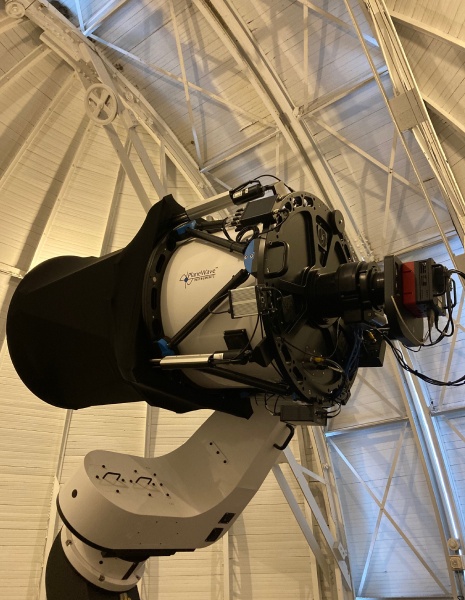- Fitz-Clark Refractor
-

Main Telescope
Refractor
Lens Diameter: 13"
Focal Length: 182"
Focal Ratio: f/14Finder Scope
Refractor
Lens Diameter: 4"
Focal Length: 39"
Focal Ratio: f/4Under the smallest dome is the 13-inch Fitz-Clark refractor. Constructed in 1861 by Mr. Henry Fitz of New York, it was the primary telescope of the original Allegheny Observatory. The Fitz-Clark is a visual refractor, which means the lens was designed to bring yellow light to a focus, where the human eye most sensitive. It was at that time the third largest telescope in the world.
The lens was stolen on July 8, 1872 and subsequently held for ransom. Samuel P. Langley, then the director of the observatory refused to pay any money for the return of the objective's lens. He realized that if the ransom were paid, it would pave the way for other lens-knappings. Professor Langley secretly met with the thief and, with the agreement the the thief would remain anonymous, the lens was returned. Unfortunately, the lens had a large scratch across the middle of it. It was then sent to Alvin Clark to be re-figured. Much to the amazement of the staff the returned lens was better than it was before the burglary, hence the two names.
The Fitz-Clark refractor has made many valuable contributions to science. In 1906 it was moved to the new Allegheny Observatory where "it was made to be forever free to the people." This telescope has been primarily used for the tour program and on occasion used to test instruments for the bigger telescopes.
Instrumentation: Santa Barbara Instruments Group (SBIG) ST-2000XM CCD imaging Camera mounted to a Taurus Image Tracker III, A Baader full aperture solar filter for direct viewing of the Sun, apparatus for doing solar projection, a multitude of 1.25 and 2 inch eyepieces.
- Thaw Refractor
-

Main Telescope
Refractor
Focal Length: 47'
Lens Diameter: 30"
Focal Ratio: f/18.8Finder Scope
Refractor
Focal Length: 96"
Lens Diameter: 8"
Focal Ratio: f/12
Eyepiece: 2" 50mm Erfle
Power: 48.8xGuide Scope
Refractor
Focal length: 47"
Lens Diameter: 8"
Ratio: f/70
Eyepiece: 1.25| 28mm RKE
Power: 511xUnder the largest dome is the Thaw Memorial Refractor. William Thaw Junior, in memory of his father William Thaw Senior donated the funds for its construction. The Thaw telescope was designed and built by the Brashear Optical company in 1912. The lens of this telescope was designed for photographic use. It was corrected to bring blue light to a focus; this is where photographic films of this time were most sensitive. The photographic program started in 1914 and to this day has collected some 110,000 exposures on glass plates. It is one of the oldest and largest collections of photographic plates in the world.
In 1985 the original lens was replaced with one that is corrected to bring the red light to a focus. The photo-multiplier tubes of the Multi-channel Astrometric Photometer (MAP) and CCD detectors are more sensitive to red light. Fortunately, the Pittsburgh skies are still fairly dark in this region of the visual spectrum.
The telescope tube is 47 feet long and has a moving mass of about 8000 pounds.
- Keeler Telescope
-

PlaneWave CDK24
Aperture: 24"
Focal Length: 3974mm
Focal Ratio: f/6.5
Fused Silica Mirrors
Field of View: 32X32 arcminutes
Camera: SBIG STX-16803 (4096X4096 pixels)
Other Links
- At Parturient
Porta Vestibulum
Integer Sociosqu
Vitae Aptent
Aptent Praesent
Rhoncus Urna
